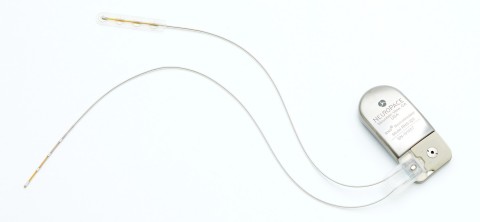MOUNTAIN VIEW, Calif.--(BUSINESS WIRE)--NeuroPace, Inc., a Silicon Valley-based medical technology company, today announced the launch of its Next Gen RNS® System for the treatment of refractory epilepsy, which affects an estimated 1 million people in the United States alone. The RNS System is a type of brain-computer interface that treats seizures by continuously monitoring brain waves, recognizing each patient’s unique “seizure onset fingerprint,” and automatically responding with imperceptible electrical pulses before seizures occur.
Epilepsy is a chronic disorder originating in the brain, characterized by unpredictable seizures. Approximately 50 million people worldwide have epilepsy, making it one of the most common neurological diseases globally.1 In the United States, more people live with epilepsy than autism spectrum disorder, Parkinson’s disease, multiple sclerosis and cerebral palsy combined. About one-third of individuals living with epilepsy are refractory to medications.2
“NeuroPace revolutionized epilepsy therapy in 2013 with the introduction of the world’s first closed-loop, brain-responsive neuromodulation system—the only device that applies brain-computer interface technology to successfully treat refractory focal onset epilepsy,” said NeuroPace CEO Frank Fischer. “We have maintained our relentless focus on product innovation, and are excited to make the Next Gen RNS System—with twice the longevity and twice the memory in the same size device—available to our physician customers and their patients.”
The Next Gen RNS System is a major advance over the existing system. The battery life of the RNS Neurostimulator has more than doubled from 3.9 to 8.4 years at medium stimulation settings, which will allow patients to live their lives with fewer interruptions. The amount of available memory has also doubled, which will allow physicians to review a wider set of brain activity data.
The first new implantation of the Next Gen RNS System took place in New York City in a procedure performed by neurosurgeon Werner Doyle, MD. “We are delighted to have a patient at NYU Langone Health be the first to receive the new device, which provides a therapeutic option for prolonged seizure control in patients with epilepsy who do not respond to medications,” says Director of NYU Langone’s Comprehensive Epilepsy Center Orrin Devinsky, MD. “Our goal as epilepsy providers is to utilize the latest technologies to explore every treatment avenue to positively impact the lives of patients with this devastating condition going forward.”
“In addition to compelling therapeutic benefits, the RNS System allows clinicians—for the first time—to view their patient’s brain activity over months and years,” notes NeuroPace Chief Medical Officer, Martha Morrell, MD. “With nearly 3 million stored electrographic recordings, we now have an unprecedented window to the brain. We are optimistic that the clinical insights gained from this large body of data will help clinicians continue to improve their patients’ outcomes and, ultimately, transform the way we treat brain disorders.”
To learn more about the Next Gen RNS System, please visit www.neuropace.com/professionals.
About the NeuroPace RNS® System
The
RNS System is the world’s first and only closed-loop brain-responsive
neurostimulation system designed to prevent epileptic seizures at their
source. As a type of brain-computer interface, the RNS System treats
seizures by continuously monitoring brain waves, recognizing each
patient’s unique “seizure onset fingerprint,” and automatically
responding with imperceptible electrical pulses before seizures occur.
The RNS System is composed of a neurostimulator, leads that are placed
at the seizure foci, a remote monitor used by patients to upload their
data, and a RNS Tablet and Patient Data Management System (PDMS) used by
physicians. Physicians can remotely view their patient’s electrographic
data on a secure website, and program the device settings to personalize
therapy for each individual’s unique brain patterns.
The RNS® System is an adjunctive therapy for adults with refractory, focal onset seizures with no more than 2 epileptogenic foci. See important safety information at http://www.neuropace.com/safety/
About the RNS System® Clinical Study Data
The
RNS System demonstrated safety and effectiveness in a rigorous
multi-center, double-blinded, randomized controlled pivotal study of 191
patients across 31 epilepsy centers. It has also been evaluated in a
Long-Term Treatment (LTT) Study, which represents the largest
prospective clinical study in the field of neuromodulation with 8 year
follow up data. The RNS System significantly reduced seizures with
continued improvement over time. At eight years, patients achieved a 73%
median reduction in seizures. Of this group, 30% of patients achieved
90% seizure reduction or better in the most recent three months, and 29%
had at least one period of 6 months or more without seizures.3
Patients also reported significant quality of life improvements,
including cognition, physical health, mental health, and seizure worry.4
About NeuroPace
NeuroPace is the global leader in the
emerging field of brain-computer interface technologies, which is
projected to become a $1.2 billion market by 2024. We are dedicated to
developing groundbreaking technology and advancing brain science to
improve the quality of life for millions of individuals who suffer from
neurological disorders. The company’s first product, the RNS System, is
the only FDA-approved brain-responsive neurostimulator for the treatment
of focal onset refractory epilepsy.
1 World Health Organization. http://www.who.int/news-room/fact-sheets/detail/epilepsy
2
Epilepsy Foundation. “Facts about Seizures and Epilepsy.” http://www.epilepsy.com/learn/epilepsy-101/facts-about-seizures-and-epilepsy
3
Presented at American Epilepsy Society meeting, Dec 2017. Combined trial
outcomes includes data from the Feasibility, Pivotal (randomized double
blind, controlled) and Long-Term Treatment Trials.
4
Meador KJ, et al. Epilepsy Behav. 2015 Apr;45:242-7





